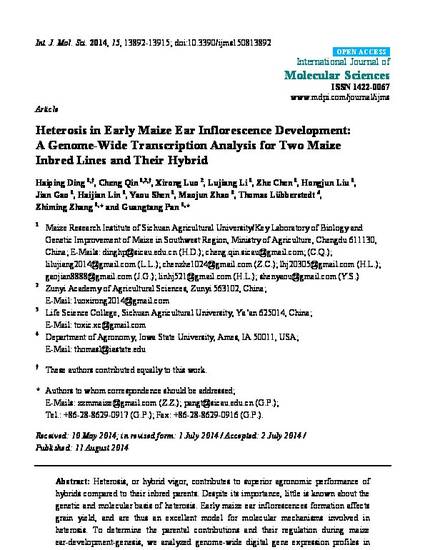
Heterosis, or hybrid vigor, contributes to superior agronomic performance of hybrids compared to their inbred parents. Despite its importance, little is known about the genetic and molecular basis of heterosis. Early maize ear inflorescences formation affects grain yield, and are thus an excellent model for molecular mechanisms involved in heterosis. To determine the parental contributions and their regulation during maize ear-development-genesis, we analyzed genome-wide digital gene expression profiles in two maize elite inbred lines (B73 and Mo17) and their F1hybrid using deep sequencing technology. Our analysis revealed 17,128 genes expressed in these three genotypes and 22,789 genes expressed collectively in the present study. Approximately 38% of the genes were differentially expressed in early maize ear inflorescences from heterotic cross, including many transcription factor genes and some presence/absence variations (PAVs) genes, and exhibited multiple modes of gene action. These different genes showing differential expression patterns were mainly enriched in five cellular component categories (organelle, cell, cell part, organelle part and macromolecular complex), five molecular function categories (structural molecule activity, binding, transporter activity, nucleic acid binding transcription factor activity and catalytic activity), and eight biological process categories (cellular process, metabolic process, biological regulation, regulation of biological process, establishment of localization, cellular component organization or biogenesis, response to stimulus and localization). Additionally, a significant number of genes were expressed in only one inbred line or absent in both inbred lines. Comparison of the differences of modes of gene action between previous studies and the present study revealed only a small number of different genes had the same modes of gene action in both maize seedlings and ear inflorescences. This might be an indication that in different tissues or developmental stages, different global expression patterns prevail, which might nevertheless be related to heterosis. Our results support the hypotheses that multiple molecular mechanisms (dominance and overdominance modes) contribute to heterosis.
Available at: http://works.bepress.com/thomas-lubberstedt/39/

This article is published as Ding, Haiping, Cheng Qin, Xirong Luo, Lujiang Li, Zhe Chen, Hongjun Liu, Jian Gao et al. "Heterosis in early maize ear inflorescence development: a genome-wide transcription analysis for two maize inbred lines and their hybrid." International journal of molecular sciences 15, no. 8 (2014): 13892-13915. 10.3390/ijms150813892. Posted with permission.